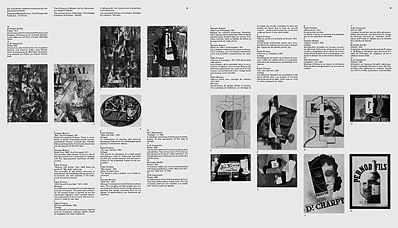Richard Paul Lohse:
The Influence of Modern Art on Contemporary
Graphic Design
The aim of this analysis is to point out the close and manifold connections between modern art and contemporary design, not only where a direct influence or derivation can be established, but also where a certain similarity exists in methods of work. With this object in view the typographical designs reproduced here have been chosen from publications which can be regarded as typical of their particular line.
In the following pages an attempt has been made to substantiate the statement that modern design derives its inspiration from the more experimental aspects of painting.
In so far as it enjoys unlimited scope and freedom painting may be regarded as the source of new creative ideas. By virtue of this quality it holds up a mirror to important ideological, spiritual and philosophical changes. Even if the pioneer is unaware of the significance of his work and its philosophical ramifications, he is nevertheless an instrument, like the seismograph of a weather-chart, which registers the largescale reactions of the age. Thus the creative work of single individuals can reflect both present and future conceptions of life and reality. In the period of Cubism we are dealing with work of the first rank which has this kind of significance.
Double page 5/6 | Larger view
(Chapter titles:)
The earliest forms of Montage / The Collage Creations of Cubism / Purism
The Theme of Movement in Art and Graphic Design / Photography / Photomontage / Futurism
The Montage Works of Dadaism / The "irrational" Montage Works of Surrealism
Suprematism / Constructivism / Stijl / Neoplasticism / The Bauhaus
Contemporary Design
Magazine article in:
Neue Grafik / New Graphic Design / Graphisme actuel
Editors: Richard Paul Lohse, Josef Müller-Brockmann, Hans Neuburg, Carlo L. Vivarelli
Nr. 1, September 1958, pages 4-35, Olten. Text also in German and French.
